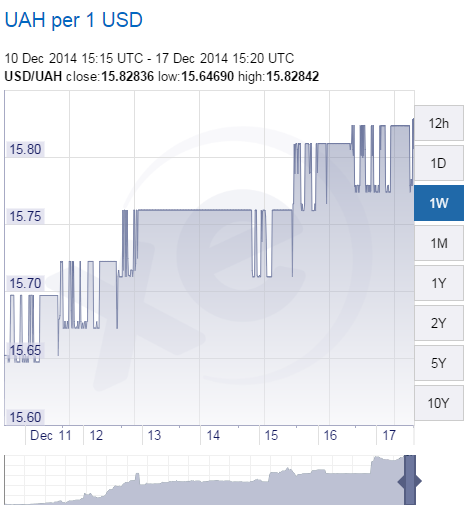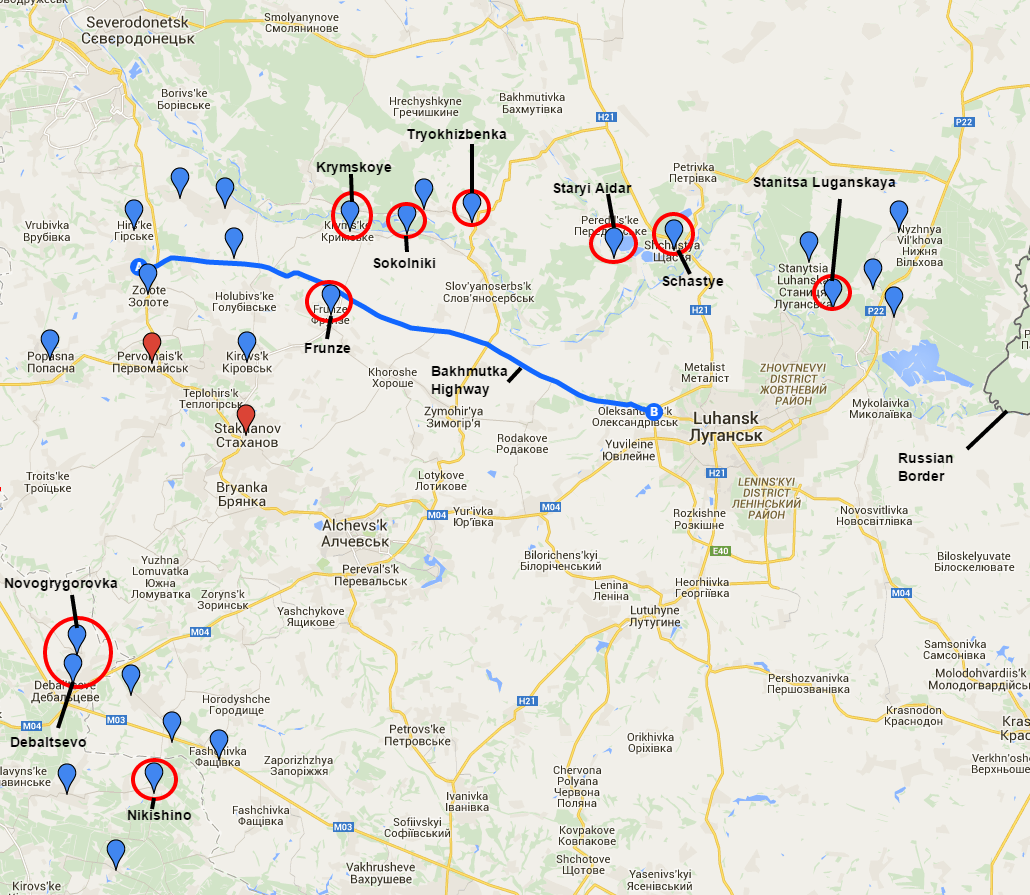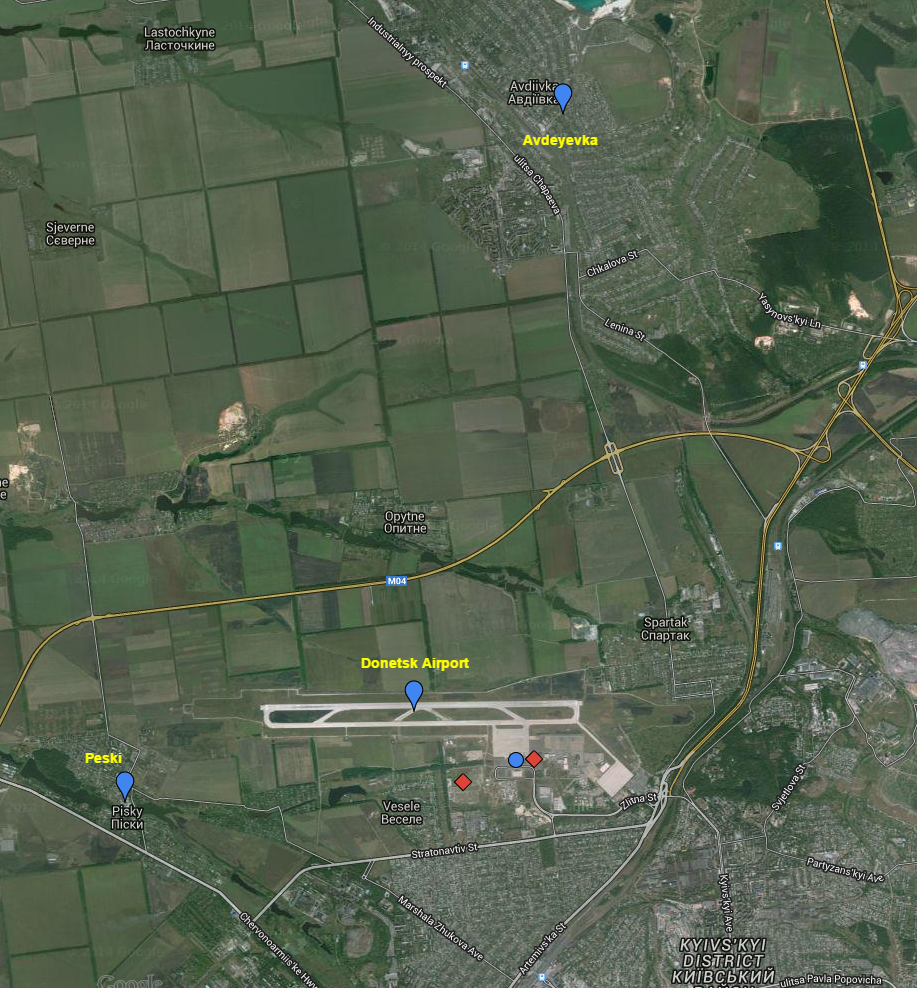Yesterday’s live coverage of the Ukraine conflict can be found here. An archive of our liveblogs can be found here. For an overview and analysis of this developing story see our latest podcast.
Please help The Interpreter to continue providing this valuable information service by making a donation towards our costs.
View Ukraine: April, 2014 in a larger map
For links to individual updates click on the timestamps.
For the latest summary of evidence surrounding the shooting down of flight MH17 see our separate article: Evidence Review: Who Shot Down MH17?
Interfax-Ukraine reports that Yelena Gitlyanskaya, a spokesperson for the Ukrainian Security Service (SBU), has told reporters at a briefing in Kiev why the Service ordered the closure of airports in Zaporozhye, Kharkiv and Dnipropetrovsk for several days from midnight on December 13.
The Interpreter translates:
“This was done on the basis of a report, which was provided (by the State Aviation Administration) to the office of one of the branches of the Ministry of Defence, that there is a major threat to civilian aircraft in the territory of the ATO zone today.
Thus, the decision was taken to carry out preventive measures based on a report received that surface-to-air missile systems, including Buk, have been deployed in territory in the Donetsk and Lugansk regions that are not controlled by Ukraine.”
The presence of SAMs in separatist-held territory is well attested to by shoot-downs and photographic evidence. A Buk system is widely regarded as the weapon with which Malaysia Airlines flight MH17 was shot down, though such systems have not been documented in Ukraine since then. Self-propelled Strela-10 launchers and numerous MANPADS have been documented frequently. It is uncertain what new specific threat the SBU is referring to here.
Kharkiv and Dnipropetrovsk airports reopened on December 16, however Zaporozhye airport is to remain closed until December 20.
— Pierre Vaux
“From what we have learned from human rights activists and several Ukrainian citizens, whose relatives were captured outside Ilovaisk and were transferred to Russia, we know of thirty people in this situation.”
According to Feygin, among these 30-or-so Ukrainians in various investigative detention centres (known as SIZO in Russian) are fighters from both “paramilitary formations,” implying members of volunteer battalions, and regular servicemen in the Ukrainian Armed Forces.
His client, Nadezhda Savchenko, was captured by separatist fighters in the Lugansk region of Ukraine and then illegally transported to Russian territory. She is now facing trial for the murder of two Russian journalists, who, the Russian Investigative Committee (Sledkom) says, were killed by a mortar strike she spotted for.
Russia has not so far acknowledged her status as a prisoner of war, claiming that Savchenko crossed the border into Russia’s Rostov region of her own will despite having been captured and filmed undergoing interrogation by separatist fighters.
On Friday December 12, Feygin reported that his client had written letters to both Sledkom and the International Committee of the Red Cross, in which explained that, as a member of the Ukrainian armed forces, she was a prisoner of war and therefore subject to such rights under the Geneva Convention.
Feygin said that, in accordance with Russia’s international obligations, the case against Savchenko must be suspended.
Today, the lawyer said that he hoped success in the Savchenko case would set a precedent and lead to the release of other Ukrainian prisoners of war in Russia.
— Pierre Vaux
Kyiv Post is calling yesterday “Black Tuesday,” the day where both the Russian ruble and the Ukrainian hryvnia hit all-time lows. Ivan Vertyuk reports that yesterday the National Bank’s official exchange rate, 15.77 hryvnia to a US dollar, is the lowest in history:
In an attempt to calm down the panic, the regulator sold $3 million on the market at a rate of Hr 15.76.
As of now, Cabinet is preparing the state budget for the next year with a currency rate forecast at Hr 22 per dollar, reports Ukrayinska Pravda, a news and opinion website. However, Prime Minister Arseniy Yatsenyuk during the Dec. 16 news briefing said the forecasted rate for 2015 is Hr 17 per dollar.
Demand for foreign currency grows as population feels little confidence in the hryvnia, preferring to use dollars or euros for keeping their savings. This pushes the banks to compete for hard currency on the interbank market, in order to be able to satisfy their clients.
Here’s what the hryvnia looks like over the last week:

On Monday we wrote an analysis that the hryvnia and the ruble. While both are the worst performing currencies in the world, they have behaved very differently and the reasons for their devaluation are not the same.
The ruble is tumbling as the result of many factors. While the dropping oil price may be the main reason, Putin’s policies meant that the Russian economy stalled when the price of oil was high. Instability, and Putin’s nationalization of an oil company, actually spooked Russia’s investors and sparked the ruble’s fall.
The hryvnia has dropped at different times and for different reasons. The currency has been significantly impacted by investor uncertainty related to several key factors: Russia’s annexation of Crimea and it’s invasion of Eastern Ukraine, Ukraine’s corruption problem, underlying problems in the government and the economy which the Yanukovych government hid from the world, and concerns about the IMF loan.
But that does not mean that the problems in Russia and the problems in Ukraine are unrelated. Lower energy prices also hurt the hryvnia, despite the fact that the currency is far less reliant on energy to stay afloat. The lower ruble also negatively impacts some who do business in Russia, which remains Ukraine’s largest trading partner. China’s economy is also struggling, and China is Ukraine’s second largest trading partner.
Another reason the hryvnia is hurting this week — the American energy giant Chevron has pulled the plug on its projects in Ukraine. Bloomberg reports:
The second-largest U.S. energy producer will pull out of an agreement for exploring the Oleska field in western Ukraine, a government official said this week. It was the final blow to the country’s dream of becoming a big shale-gas producer after Royal Dutch Shell Plc (RDSA) retreated earlier this year from a similar deal in eastern provinces riven by a bloody war with pro-Russian separatists.
While Chevron can walk away unscathed, for Ukraine it’s another blow to the prospects of reviving a chaotic economy that remains dependent on Russia, a country it claims to be in armed conflict with. Already weighed down by the war that’s killed more than 4,600 people and teetering on the verge of default, Ukraine was counting on foreign capital to develop its domestic gas resources.
“Foreign investment will start to flow only if there is a healthy, predictable investment environment based on the rule of law,” said Ulrich Benterbusch, managing director at German energy agency Dena. “This includes drastic measures to reduce the endemic corruption.”
Chevron grew frustrated with the Ukrainian government’s failure to modify tax rules under which foreign explorers have to operate in the country, said Allen Good, an energy industry analyst at Morningstar Inc. in Chicago.
The Russian state-owned TASS news agency reports that Denis Pushilin, the ‘deputy speaker’ of the ‘People’s Soviet of the Donetsk People’s Republic,’ has said that the Donetsk-based separatists are prepared to exchange 152 captured Ukrainian soldiers.
Speaking to a TASS correspondent, Pushilin said (translated by The Interpreter):
“There is a list of people whom we are prepared to exchange as soon as tomorrow. We know where they are located and this issue can be resolved promptly. We are prepared to let go of 152 people.”
According to Pushilin, the Ukrainian government has announced that it its prepared to release 223 captured militants in an exchange.
Pushilin added:
“After this we will have to move onto the next stage and shall full information on the locations of prisoners so that absolutely all of them can be exchanged. That was how it was in the agreement.
They only have ours on a list of 800 people. But there are also representatives from the Ukrainian side for whom we also feel responsibility. These are, for example, officers in the Ukrainian army who withdrew from encirclement together with their soldiers, found themselves on the territory of the DNR or the Russian Federation, and now face prosecution for political reasons and 7 to 10 years in prison.”
— Pierre Vaux
The coalition agreement signed by Ukrainian politicians as the basis of the current government requires that Ukraine abandon it’s non-aligned status (which it has held since the fall of the Soviet Union) and sets a goal of NATO membership.
While membership of the military alliance seems a far-off prospect at the moment given the cool reactions from French and German leaders, the renunciation of Ukraine’s non-aligned status appears to be closer at hand.
UNIAN reports that the ATO press centre has announced that 26 attacks by Russian-backed forces have been recorded over the last 24 hours.
According to the press centre, Russian-backed fighters attacked Ukrainian positions with artillery, mortars, rocket-propelled grenades and small arms.
As in recent days, the militants’ attacks were concentrated in the areas around Luhansk, Donetsk, Debaltseve and Pervomaisk. In addition, there were attacks on Shastya, Stariy Aidar, Stanychno-Luhanske, Trekhizbenka, Krymske, Sokolnyky, Pisky, Avdiivka, Nikishyne, Novogrygorovka, and Frunze.
The rebels also attacked Donetsk airport six times.
Ukrainian artillery did not return fire. Ukraine’s armed forces have been ordered to cease firing, and not to return fire even if attacked by the militants.
From 0320 to 0440 in the vicinity of the village Talakovka an enemy drone was spotted flying at a height of 2 kilometers.
“Our anti-aircraft gunners were watching it, but, they observed the ‘silence regime’ and did not open fire,” the press center statement said.
Most of these reported attacks are concentrated along the front line running from Debaltsevo on the eastern fringes of the Donetsk region through northern Lugansk to Stanitsa-Luganskaya, near the Russian border.
Here is a map highlighting the locations attacked (note that The Interpreter uses Russian-language place names rather than Ukrainian, as used by UNIAN above):

Novosti Donbassa reported on further details from the military on the situation in Debaltsevo.
A spokesman for the Ukrainian army said (translated by The Interpreter):
Heavy-calibre machine guns, mortars and shots from rocket-propelled grenades have been heard. The terrorists have fired two salvoes from Grad rocket launchers at Debaltsevo. Saboteurs are not abandoning their attempts to get close to ATO forces’ positions during the nights.
Shelling is audible on the beginning of this video from the Ukrainian Armed Forces’ YouTube channel, from which Novosti Donbassa extracted the quotation above:
One soldier interviewed reports that the shelling is almost daily. They are unsure of the origin of most of the attacks though they sometimes see flashes on the horizon as Russian-backed fighters fire from neighbouring towns or slag heaps.
The other attacks were concentrated around the north of Donetsk, at the airport and the Ukrainian held-settlements of Peski and Avdeyevka:

— Pierre Vaux
In the early hours of this morning we reported on the Kremlin’s announcement of a conference call held last night in the “Normandy format” between President Vladimir Putin, President Petro Poroshenko, Chancellor Angela Merkel and President François Hollande.
Here is The Interpreter‘s translation of the announcement:
The discussion of the crisis situation in Ukraine is continuing. In the context of international efforts to foster a peaceful settlement of the internal Ukrainian conflict the need to ensure a durable ceasefire in the Donbass was noted.
The importance was noted of a rapid convening of a meeting of the contact group in the interests of implementation of the Minsk agreements and establishment of a dialogue between Kiev and the southeast. Among the priorities, in particular, are designated an exchange of forcibly-held persons and the withdrawal of heavy artillery from the line of contact by the conflicting sides.
The questions of issues of economic restoration of suffering regions and provision of humanitarian and social support for the population were also discussed.
It was agreed to continue telephone contacts in the “Normandy format” in the near future.
The office of the Ukrainian president, Petro Poroshenko, has now released their own account of the discussion:
The parties have discussed the situation in the Donbas and the fulfillment of the Minsk protocol of September 5 and the Minsk memorandum of September 19. Petro Poroshenko, Francois Hollande, Angela Merkel and Vladimir Putin have agreed on the necessity of compliance with all items of those agreements for the peaceful resolution of the situation in the Donbas.
The parties have agreed to hold the meeting of the Trilateral Contact Group to ensure progress in the fulfillment of the Minsk agreements by the end of the week. Particularly, the agenda of the given meeting will include the issue of the ceasefire, pullback to the delimitation line laid down in the Memorandum, withdrawal of troops and heavy armament, as well as immediate liberation of all hostages. Also, the President has drawn attention to the necessity of liberation of people’s deputy Nadiya Savchenko from Russian prison. Her health conditions have become worse.
The parties have agreed to continue phone negotiations in Normandy format in several days in order to monitor the results of the agreements achieved in the given format.